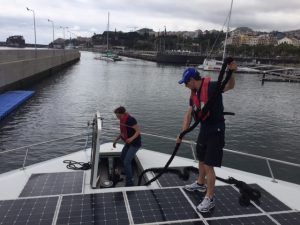Today, Race for Water set sail on her first transatlantic crossing, powered only by her kite and solar panels. Director of Operations Franck David explains the challenges of zero-emissions yachting.
Crossing the Atlantic is a whole different kind of yachting. Conditions and weather play a much greater role than when you’re cruising along a coastline, as Race for Water did on her maiden voyage from Lorient (France) to Madeira. On their way across the Atlantic, Race for Water and her crew will have to deal with many different types of weather, including the major depressions we’re seeing near Bermuda right now. We know that those depressions always move from West to East, so they’re heading in Race for Water’s direction, and the crew will have to handle them accordingly. Our crew for this leg is smaller than for Race for Water’s maiden voyage—only seven people are on board: five crewmembers, Expedition Leader Marco Simeoni, and an engineer from SkySails, the German firm responsible forh Race for Water’s kite drive system.
Race for Water enjoyed favorable wind patterns during her maiden voyage. Conditions were mild and the prevailing tailwinds allowed the crew to use the yacht’s innovative kite drive system quite a bit. On this leg to Bermuda, we know that Race for Water will be sailing into the wind and waves. We’re counting on Captain Pascal Morizot and Engineer Martin Gavériaux to make the right decisions during the crossing. On board Race for Water, they receive four weather reports per day, with forecasts for wind, sun, and waves, and they use those to plot the best course in terms of Race for Water’s available power.
Sailing under solar and wind power
Here on land, we don’t make any decisions for the crew; we just talk through the route options based on Race for Water’s speed and the conditions out on the ocean. Operating solely on solar and wind power is a learning experience for all of us, and we refined the system during Race for Water’s maiden voyage from Lorient (France) to Madeira. The crew had to learn how to manage the yacht’s two power sources: solar panels and the kite drive system. That gave us a better idea of the speeds we can expect from Race for Water in different wind and sun conditions, using the kite, solar power, or a combination of the two.



Using this data, we can fine-tune Race for Water’s course, and make the best decisions for the yacht’s unique capabilities. Aside from that, the most important factor is our crew’s morale and the atmosphere on board Race for Water, and we’re confident that everything is going really well from that point of view.
On behalf of the entire Race for Water team, thanks for following our journey!